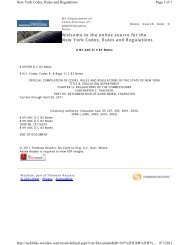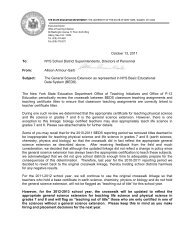ESL Learning Standards - Higher Ed - New York State Education ...
ESL Learning Standards - Higher Ed - New York State Education ...
ESL Learning Standards - Higher Ed - New York State Education ...
You also want an ePaper? Increase the reach of your titles
YUMPU automatically turns print PDFs into web optimized ePapers that Google loves.
Advanced<br />
Students read/discuss a book on emotions (as mentioned in<br />
Intermediate task). Students cut out magazine pictures that<br />
show different emotions and hang these pictures around<br />
the room. Each student secretly selects one to describe<br />
and interpret in detail (orally and/or in writing) to the rest<br />
of the class. Other students guess which picture it is, and<br />
discuss whether they agree with the interpretation and<br />
why. Students select one of the emotions depicted in a<br />
picture and, through the writing process, write about an<br />
emotional experience (e.g., feeling sad about leaving their<br />
country). Students share final drafts and compile stories<br />
into a class feelings book.<br />
Performance indicators: 3, 4, 6<br />
English Proficiency Level<br />
Transitional<br />
Students complete Advanced task. Class brainstorms a list<br />
of important events (e.g., wedding, funeral, birth, graduation,<br />
relocation). In pairs, students research (through<br />
Internet, books, and interviews) the ways these events are<br />
commemorated in different (including students’ native) cultures<br />
and in the U.S., paying attention to how grief, happiness,<br />
excitement, etc. are expressed. Share and discuss<br />
findings in class.<br />
Performance indicators: 2, 3, 4, 5, 6<br />
Class brainstorms a few social situations to be enacted<br />
through role-plays (see Intermediate task). After the roleplays,<br />
pairs of students develop and act out a selected situation.<br />
Students present possible alternative language for<br />
scene and explain why they made the language choices<br />
they did (see Intermediate task).<br />
Performance indicators: 1, 4<br />
Teacher shares one of the books listed as part of the<br />
Intermediate task, and small groups of students read additional<br />
books. Groups present books to class. Class creates<br />
and fills out chart (including pertinent information from the<br />
books as well as personal experiences), as in Intermediate<br />
task. Class uses the information in the chart to collaborate<br />
on a simple illustrated “problems/solutions” guide for<br />
newly arrived students.<br />
Performance indicators: 3, 4, 6<br />
Students complete Advanced task, but each pair acts out<br />
appropriate and less appropriate language and ways of<br />
interacting in various situations. Class is asked to select<br />
which is appropriate and why. The role-plays and ensuing<br />
discussions and evaluations are videotaped for future use<br />
with <strong>ESL</strong> students.<br />
Performance indicators: 1, 4<br />
Students complete Advanced task. Before creating the<br />
guide for newcomers, class brainstorms a list of additional<br />
helpful information about school in America (e.g., useful<br />
phrases, school personnel, calendar, map, daily schedule,<br />
school rules, procedures for cafeteria and library use).<br />
Guides are made available upon registration of new <strong>ESL</strong><br />
students and/or at <strong>ESL</strong> orientation meetings.<br />
Performance indicators: 2, 3, 4, 6<br />
<strong>ESL</strong><br />
5<br />
Elem<br />
Continued on next page<br />
CLASSROOM<br />
TASKS<br />
Sample Classroom Tasks 65
















